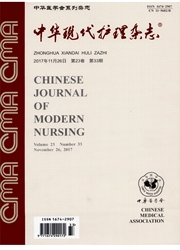

 中文摘要:
中文摘要:
目的探讨肝胆胰外科术后发生应激性高血糖患者实行血糖控制优化方案的临床效果。方法将2012年1—6月进行肝胆胰相关手术,且术后发生应激性高血糖的86例重症患者作为研究对象,按随机数字表法随机分为对照组和观察组,每组各43例。均将50u中性胰岛素加入48.75ml0.9%氯化钠注射液,经微量泵静脉输注,控制患者血糖在7.8~10.0mmol/L。观察组和对照组分别应用血糖控制优化方案和传统方法进行胰岛素调节。结果血糖达到控制目标值,观察组用时(4.54±1.51)h,对照组用时(8.64±2.68)h,差异有统计学意义(t=2.84,P〈0.05);高血糖指数观察组为(0.86士0.24),低于对照组的(1.97±0.94),差异有统计学意义(t=2.95,P〈0.05);低血糖、严重低血糖及50%葡萄糖抢救等不良事件发生例数观察组少于对照组,差异有统计学意义(X2值分别为6.541,4.195,14.577;P〈0.05);腹腔感染、切口感染和肺部感染的发生例数观察组少于对照组,差异有统计学意义(x。值分别为5.108,6.198,3.957;P〈0.05)。结论血糖控制优化方案用于肝胆胰外科术后发生应激性高血糖患者,能更好、更快、更安全地控制血糖,减少低血糖等不良事件和腹腔感染等并发症的发生。
 英文摘要:
英文摘要:
Objective To study the clinical effect of blood glucose control optimization on stress hyperglycemia of patients after abdominal surgery. Methods Totals of 86 cases of serious patients who had suffered from abdominal surgery from January to June 2012 and suffered from postoperative stress hyperglycemia were selected and randomly divided into the control group and the observation group, with 43 cases in each group. In both groups, 50 U neutral insulin was added into 48.75 ml of 0. 9% sodium chloride injection, and venous transfusion was done by micro pump to control blood glucose between 7.8 and 10.0 mmol/L. Blood glucose control optimization and traditional methods were respectively used in the observation group and the control group. Results Compared to the control group, blood glucose of patients in the observation group reached the target value more quickly. The time was (4.54 ± 1.51 ) h in the observation group and ( 8.64± 2.68) h in the control group, and the difference was statistically significant ( t = 2.84, P 〈 0.05 ). The hyperglycemic index was (0.86 ± 0.24) in the observation group and ( 1.97 ± 0.94) in the control group, and the difference was statistically significant ( t = 2.95, P 〈 0. 05 ). The incidence of adverse events such as hypoglycemia, severe hypoglycemia and 50% glucose rescue was lower in the observation group than in the control group, and the differences were statistically significant (X2 = 6.541,4. 195,14. 577, respectively; P 〈 0.05). The incidence rate of abdominal infection, incisional wound infection and pulmonary infection were also lower in the observation group than in the control group, and the differences were statistically significant (X2 = 5. 108,6. 198,3. 957, respectively; P 〈0.05). Conclusions Blood glucose control optimization on patients after abdominal surgery can control patients' blood sugar better, quicker and safer, as well as reduce the incidence of adverse events including hypoglycemia, abdominal infection and so on.
 同期刊论文项目
同期刊论文项目
 同项目期刊论文
同项目期刊论文
 期刊信息
期刊信息
